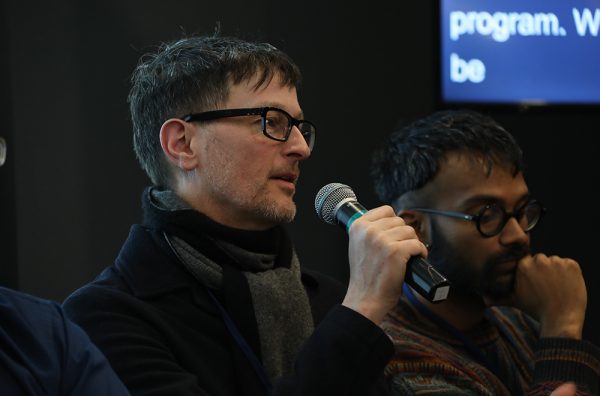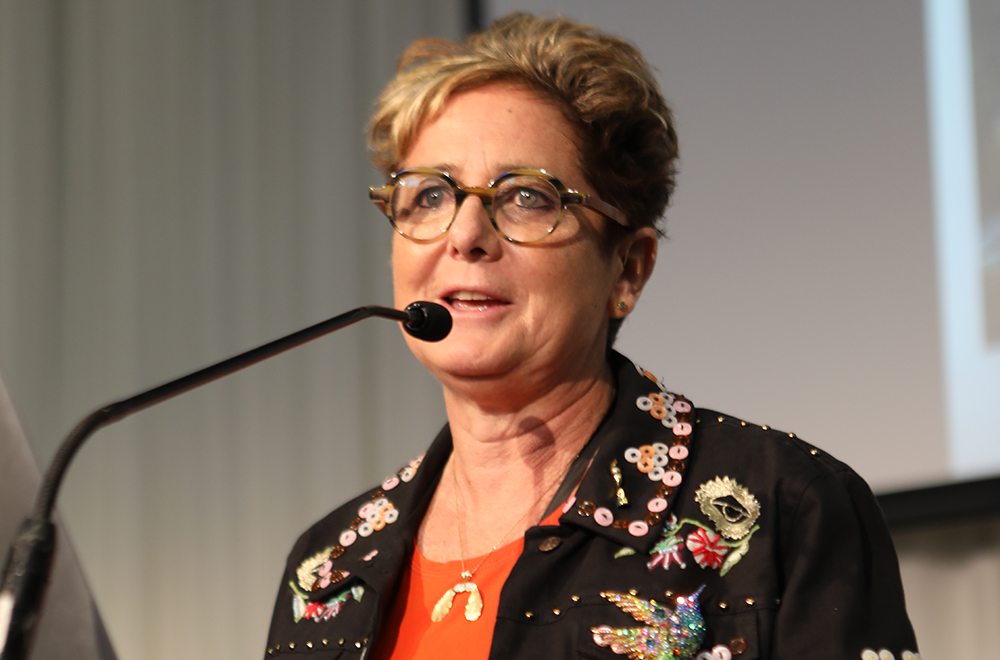Designed to make the arts, culture and events more accessible for people with disability, Arts Activated 2019, was held in Sydney recently.
Among the keynote speakers was UK artist Dr Rachel Gadsden,( pictured), who, through her extensive work in all aspects of her art, is helping to break down some of the barriers surrounding disability.
She said she had become a disability activist in the hope that the younger generation of artists will also have the opportunity to become the artist she was lucky to be. “The struggle we are still fighting for is not a level playing field and probably won’t be for another 100 years. We have to be out there, be activists, and tell the world to ‘wake-up, grow-up and include me in everything’. We cannot stay isolated. “
Gadsden had some advice for artists in the community. “As an artist you get a platform that you don’t get in any other way and we do have a responsibility to use our talents and abilities in the best possible way. Often I tell younger people with disability, who say they cannot do this or that, I know what you can do because I have been there. We can spend a lot of our life not being able to do things, so don’t miss the opportunity to do what you can do and find a way to do it.
“When I found out about my vision impairment I wanted to be open minded about what was possible and where things were going but I was terrified that I would not be able to create the work I wanted. As a disabled person you get more challenges as you get older, but I went with the flow and took opportunities that came my way. Believe me the only way you get work is if you apply a lot and you also fail a lot – the art world is very competitive and I still fail daily. This is part and parcel of what being an artist is about, not being disabled, but about being an artist.”
Gadsden was mindful of articles written because: “I am not into victim/hero stories. Quite often I will be asked by newspapers wanting to write about my work, but if it’s not in the arts section, but in health and social section I reject them. Where possible make friends with good writers and try and make them write about your art and get it published that way. But it’s a problem we have to fight together.”
The ‘D’ word also raised more questions than it answered
Among the robust panel discussions was the often controversial decision about the correct or appropriate words to describing the sector. Disability, disabled, etc?
Member of the UN Committee on the Rights of Persons with Disability, Rosemary Kayess, told delegates she moved seamlessly around the world from a disabled person, to person with disability, person with part-disability, people with lived experience, with impairment, with disabilities.
“It is irrelevant for me because it is the context with the person. Let the person decide. The policy in Australia utilises person with disability. That came from the disability movement in the mid-80s when I first became a disabled person. Then there was a huge argy-bargy, we don’t want the disability first we want the person first. It came from people with disability. Let them use it if they want to, and if you don’t want to then don’t get hung-up on it.”
According NSW Department of Planning, Industry & Environment, director for inclusive infrastructure, Paul Nunnari, for a long time the word disabled, or disability, has been taken away from people with disability and redefined into something that is negative.
“It is time we took it back to what it means. There is nothing inappropriate about the word it can be all embracing but currently it is not.”
Another topic for discussion was how arts workers with disability could access training opportunities from mainstream organisations.
National Institute of Dramatic Art executive director of Pathways & Partnerships, Mark Gaal, (pictured), acknowledged that NIDA needed to be more inclusive and proactive in order to reflect people from diverse communities. “There is lot to think about to make the changes that reflect what Australia is and not just a part.” He said the professional entertainment industry is limited in the opportunities it gives a whole range of people. “Places of training have to allow for stories that are not being told so that in the future this will become the norm.”

However, Rachel Gadsden made the point that not all people want to tell their stories but be part of the mainstream and there needs to be a major shift in the way this was done. She also asked the panel why programs had to be changed for those with disability. “There is an assumption that disabled people are not able to reach levels or degrees of professionalism that exist and the point we need to start at is why we are even speaking in those terms.”
Head of BA Performance in BSL at the Royal Conservatoire Scotland, Claire Lamont, said it is one of the few companies in the world with courses for training deaf actors and theatre makers.
“Our degree program is in its fifth year but it was not set up magically. There was a theatre for deaf artists who could not find anywhere to be trained so the artistic director went to the boss of RCS. They had trained together when they were younger and started a program with night classes with about eight students.” Lamont said you can make it happen as long as it does not get killed by bureaucracy. “Just tell us what we need to do and act. We don’t need to know what the rules are, except it has to happen now, and not wait to try and figure it out.”
Australian Film Television and Radio School (FTRS) engagement coordinator Gary Paramanathan, (pictured), agreed that people with disability are the least represented in the industry and often the focus is on the person with disability and their story.
“We have students with physical challenges and although not changing the course in any way we have adjustments to make sure the assessments are not unreasonable. For example we have a student who is hearing impaired doing our BA program and he has been fine using our audio. However in the production stage it was difficult for him to cope so we applied for a funding grant to hire an Auslan interpreter during production when there were a lot of conversations going on. We had a radio student who was sight impaired and modified our radio software to make it easier for him to use and also put our lecturers and tutors through a course on how not to exclude a person who is visually impaired.”
Associate Professor, Paul Sabey, head of performing arts, Queensland Conservatorium, Griffith University said the most important thing was that courses could be changed and shaped to fit abilities. “We audition and hopefully look to take the best, but the best is not always the person who can deliver all those skills. The best is really the person who is committed to learning. And they are two different things. I would like to make our doors wide open and for people to give us a go. From my time in London having students working together from all fields and all abilities was a beautiful learning experience.”
Comment below to have your say on this story.
If you have a news story or tip-off, get in touch with Freedom2live’s managing online editor Kymberly Martin at kymberly@intermedia.com.au
Sign up to Freedom2Live’s newsletter.

